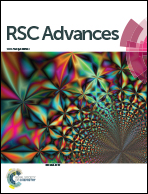Double helicity induction in chiral bis(triphenylacetamides)†
Abstract
A combination of experimental methods (ECD, X-ray diffraction) and theoretical calculations allowed the description of chirality transfer in bis(triphenylacetamides). For the first time it has been shown that effective helicity induction in a trityl chromophore is not only due to the presence of stereogenic center(s) but is also caused by other chirality inductors such as an axis of chirality. For all experimental and computed ECD spectra a uniformly identical sequence of signs of the Cotton effects has been found: negative at around 215 nm and positive below 200 nm. This result can only be explained by the dependence of the ECD spectra on the R absolute configuration of the proximal stereogenic element. The chirality transfer is achieved through a series of weak intramolecular interactions. Helicities of the trityl chromophores and their propeller shapes are influenced by the structure of the chiral inductor and the steric hindrance at amide nitrogen atoms. The stereogenic centers in the diamide unit act independently as chirality inductors and the direct trityl⋯trityl interactions are only rarely observed. Characteristic for the investigated crystals is the complete hindrance of the amide NH groups and their inability to be involved in any intermolecular interactions as well as their highly restricted ability for the formation of intramolecular hydrogen bonds. This results from the presence of Tr groups, which act as supramolecular NH protecting groups, especially when attached to the rigid carbocycles.


 Please wait while we load your content...
Please wait while we load your content...